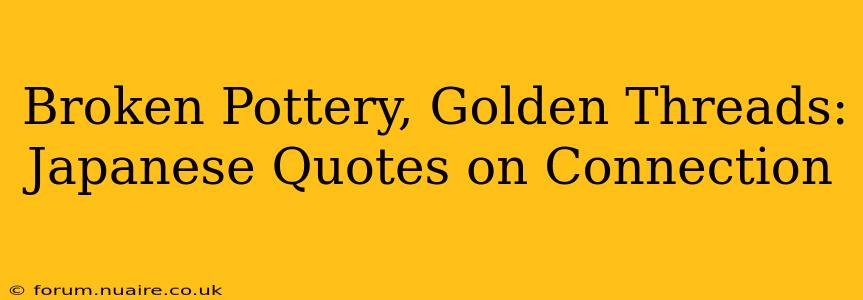The beauty of kintsugi, the Japanese art of repairing broken pottery with gold, serves as a powerful metaphor for life and relationships. Just as cracks and imperfections can be transformed into something exquisite, so too can the challenges and ruptures in our connections be avenues for deeper understanding and stronger bonds. This exploration delves into Japanese quotes that illuminate the profound nature of connection, resilience, and the transformative power of embracing imperfection. We'll uncover the wisdom embedded in these ancient words, exploring how they resonate with modern experiences of relationships, self-acceptance, and finding beauty in the unexpected.
What are some Japanese quotes about connection?
This question forms the core of our exploration. Instead of simply listing quotes, we'll analyze their nuances and delve into their underlying philosophies. Many Japanese proverbs and sayings indirectly speak to connection, emphasizing community, empathy, and the interconnectedness of all things. These are not always explicitly stated as "quotes about connection," but rather, their meaning reveals itself through interpretation and understanding of the cultural context.
How do Japanese proverbs reflect the concept of connection?
Japanese proverbs often utilize nature imagery to convey profound truths about human relationships. For instance, the image of a single bamboo stalk bending in the wind, but never breaking, symbolizes resilience and adaptability within a community. The interconnectedness of the bamboo forest reflects the strength found in mutual support and shared experiences. This imagery implicitly highlights the importance of connection and the support system it provides.
What is the significance of Kintsugi in understanding connection?
Kintsugi, as mentioned earlier, is a potent symbol of embracing imperfection. The golden seams that mend broken pottery don't merely hide the damage; they celebrate it, highlighting the history and resilience of the object. Similarly, the challenges and conflicts within our relationships can be viewed not as flaws to be erased, but as opportunities for growth and strengthening of the bond. The golden threads of understanding and forgiveness weave a narrative of shared experience, making the connection even more beautiful and meaningful.
What are some modern interpretations of Japanese proverbs on relationships?
While ancient, these proverbs retain striking relevance in today's world. The emphasis on harmony (wa 和), respect (sonkei 尊敬), and empathy (empathy 共感) remains crucial for navigating the complexities of modern relationships. The concept of "amae" (甘え), a subtle dependence and reliance within a close relationship, speaks to the need for vulnerability and trust in forging strong connections. In a fast-paced, often isolating world, these proverbs offer timeless wisdom about building meaningful connections based on mutual respect, understanding, and acceptance.
How can we apply these principles to improve our relationships?
The wisdom gleaned from these Japanese perspectives offers a practical framework for nurturing stronger connections. By cultivating empathy, practicing active listening, and embracing vulnerability, we can foster deeper understanding and resilience within our relationships. Just as kintsugi transforms broken pottery into something beautiful, so too can we transform conflict and challenges into opportunities for growth and stronger bonds. Acknowledging imperfections, both in ourselves and others, and embracing a philosophy of forgiveness and understanding lays the foundation for lasting, meaningful relationships.
Conclusion: Finding Beauty in the Broken
The Japanese perspective on connection, as reflected in its proverbs and artistic traditions like kintsugi, offers a unique and valuable lens through which to view our own relationships. Embracing imperfection, fostering empathy, and celebrating resilience are not simply abstract concepts but practical tools for building stronger, more meaningful connections. The journey of connection is not always smooth; it's often punctuated by cracks and challenges. But it's within these imperfections that we discover the true beauty and enduring strength of human connection. The golden threads of understanding and shared experience weave a tapestry of resilience, transforming broken pieces into something even more valuable and meaningful.

